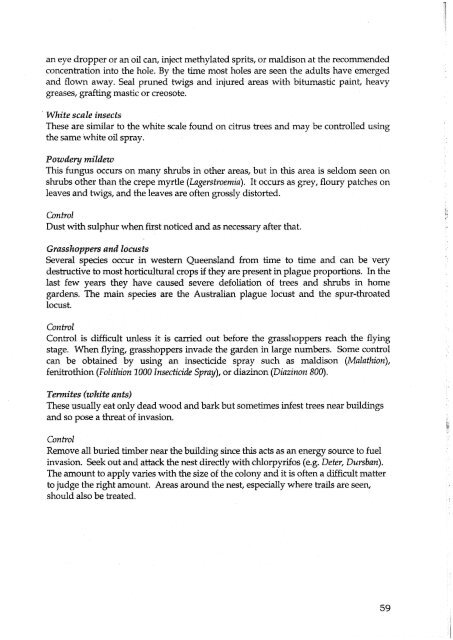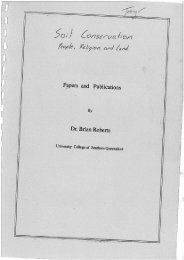western-queensland-gardening-guide.pdf - South West NRM
western-queensland-gardening-guide.pdf - South West NRM
western-queensland-gardening-guide.pdf - South West NRM
You also want an ePaper? Increase the reach of your titles
YUMPU automatically turns print PDFs into web optimized ePapers that Google loves.
an eye dropper or an oil can, inject methylated sprits, or maldison at the recommended<br />
concentration into the hole. By the time most holes are seen the adults have emerged<br />
and flown away. Seal pruned twigs and injured areas with bitumastic paint, heavy<br />
greases, grafting mastic or creosote.<br />
mite scale insects<br />
These are similar to the white scale found on citrus trees and may be controlled using<br />
the same .white oil spray.<br />
Powdery mildm<br />
This fungus occurs on many s<br />
shrubs other than the crepe myrtle (Lagerstroemia). It occurs as grey, floury patches on<br />
leaves and twigs, and the leaves are often grossly distorted.<br />
Control<br />
Dust with sulphur when first noticed and as necessary after that.<br />
Grasshoppers and lonrsts<br />
Several species occur in <strong>western</strong> Queensland from<br />
destructive to most horticultural crops if they are pres<br />
last few years they have caused severe defoliation of<br />
gardens. The main species are the Australian plague locust and the spur-throated<br />
locust.<br />
Control<br />
Control is difficult unless it is carried out before the grasshoppers reach the flying<br />
n flying, grasshoppers invade the garden in large numbers. Some control<br />
can be obtained by using an insecticide spray such as maldison (Malathion),<br />
fenitrothion (Folithion 1000 Insecticide Spray), or diazinon (Diazinon 800).<br />
ites (white ants)<br />
These usually eat only dead wood and bark but sometimes infest trees near buildings<br />
and so pose a threat of invasion.<br />
Con fro1<br />
Remove all buried timber near the building since this acts as an energy source to fuel<br />
invasion. Seek out and attack the nest directly with chlorpyrifos (e.g. Deter, Dursban).<br />
The amount to apply varies with the size of the colony and it is often a difficult matter<br />
to judge the right amount. Areas around the nest, especially where trails are seen,<br />
should also be treated.
















